Regents approve tuition increase
September 21, 1987
Plans made to urge legislators for changes in higher education policy
Despite the efforts of a group of student protestors and disapproval of the three non-voting student Regents, the Board of Regents Friday unanimously passed a $150 tuition increase.
Talk of an increase had been circulating since Gov. James Thompson’s proposed tax increase was speculated to be a failure.
After the Finance/Facilities Committee approved a formal recommendation Thursday, Regent Clara Fitzpatrick said she expected a unanimous decision in favor of the increase.
egents Chancellor Roderick Groves said, “It’s quite obvious the system and the universities have suffered a major financial reverse. Unfortunately we have nowhere to turn for additional funds than tuition.”
Student Regents Nick Valadez, NIU; Chuck Sutton, Illinois State University; and Brian Hopkins, Sangamon State University, went on record as saying if they had voting rights, they would have voted against the increase.
The board also resolved Friday to urge “the general assembly and the governor to work together for changes in higher education policy” in order to generate enough money to maintain an adequate level of education. This resolution, which the board passed, was drawn up by the student Regents.
Sutton said more pressure should be put on the general assembly because accepting a tuition increase will set a bad precedent.
Before reading the resolution, Valadez said, “I did not expect that one of the first actions I would take on this board would be to raise the tuition burden on students over 25 percent.”
e listed accomplishments by various departments of the university. Valadez said he heard the discouraging words of department chairmen and said, “I couldn’t help but notice while speaking with the department heads that they were proud of their achievements. I also couldn’t help but notice the discouragement as the reality of the budget cuts set in.”
Groves said Thompson’s statewide budget cut, which resulted in a $9.1 million reduction in the Regency system’s budget, was only one justification for the tuition increase. Other reasons included unavoidable costs and inflation, Groves said.
All the Regency universities—NIU, ISU and SSU—have experienced an unexpected enrollment increase, he said. Groves said this is because of the goal of a high retention rate, which normally is a good quality.
Groves said, however, even with the tuition increase, a gap between what the Regency schools need to operate and the amount of funds available still would exist.
Dick Beard, University Professors of Illinois representative, said the union “awarded the legislature a grade of incomplete.” He said the tuition increase “should be rolled back when the legislature gets its incomplete removed.”
Part of the additional funds provided by the tuition increase should be used for salary increases, Beard said.
owever, Groves said, “I must emphasize this calculation (of the severity of the gap) has not been made on the basis of salary increase. It was made entirely on other grounds.”
The Regency system was appropriated $188.4 million for the fiscal year 1988 by the Illinois General Assembly, Groves said. However, he said the system requested $224 million and Thompson had recommended $206 million, he said.
Alan Voelker, Joint University Advisory Committee spokesman, said the focus has been on the students and “the hit on faculty and universities has seemed to be forgotten.”
Another method to combat the budget base reduction is limited admissions. NIU President John LaTourette said a reduction of about 1,500 students still will be necessary for next fall.






